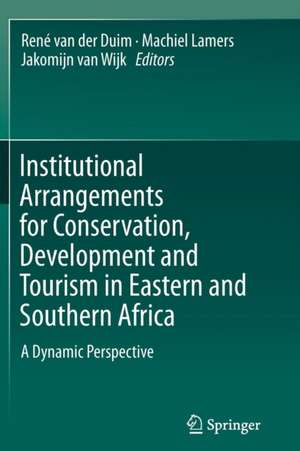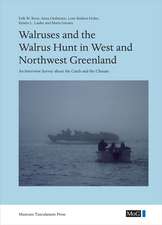Institutional Arrangements for Conservation, Development and Tourism in Eastern and Southern Africa: A Dynamic Perspective
Editat de René van der Duim, Machiel Lamers, Jakomijn van Wijken Limba Engleză Paperback – 23 aug 2016
| Toate formatele și edițiile | Preț | Express |
|---|---|---|
| Paperback (1) | 640.06 lei 6-8 săpt. | |
| SPRINGER NETHERLANDS – 23 aug 2016 | 640.06 lei 6-8 săpt. | |
| Hardback (1) | 646.30 lei 6-8 săpt. | |
| SPRINGER NETHERLANDS – dec 2014 | 646.30 lei 6-8 săpt. |
Preț: 640.06 lei
Preț vechi: 753.01 lei
-15% Nou
Puncte Express: 960
Preț estimativ în valută:
122.47€ • 127.88$ • 101.13£
122.47€ • 127.88$ • 101.13£
Carte tipărită la comandă
Livrare economică 15-29 aprilie
Preluare comenzi: 021 569.72.76
Specificații
ISBN-13: 9789402408126
ISBN-10: 9402408126
Pagini: 285
Ilustrații: XX, 265 p. 16 illus., 7 illus. in color.
Dimensiuni: 155 x 235 x 15 mm
Greutate: 0.41 kg
Ediția:Softcover reprint of the original 1st ed. 2015
Editura: SPRINGER NETHERLANDS
Colecția Springer
Locul publicării:Dordrecht, Netherlands
ISBN-10: 9402408126
Pagini: 285
Ilustrații: XX, 265 p. 16 illus., 7 illus. in color.
Dimensiuni: 155 x 235 x 15 mm
Greutate: 0.41 kg
Ediția:Softcover reprint of the original 1st ed. 2015
Editura: SPRINGER NETHERLANDS
Colecția Springer
Locul publicării:Dordrecht, Netherlands
Cuprins
Preface.- Chapter 1. Novel institutional arrangements for tourism, conservation and development in eastern and southern Africa.- Chapter 2. From exploitation to ownership: Wildlife-based tourism and communal area conservancies in Namibia.- Chapter 3. The Tsiseb conservancy: how communities, the state and the market struggle for its success.- Chapter 4. Community-based natural resource management in Botswana.- Chapter 5. Community Empowerment through Community-based Tourism: The Case of Chobe Enclave Conservation Trust in Botswana.- Chapter 6. Private game reserves in Southern Africa.- Chapter 7. False legitimacies: The rhetoric of economic opportunities in the expansion of conservation areas in southern Africa.- Chapter 8. Hunting for conservation? The re-introduction of sport hunting in Uganda examined.- Chapter 9. The evolution and progression of Transfrontier Conservation Areas in the Southern African Development Community.- Chapter 10. The Selous-Niassa Transfrontier Conservation Area and Tourism: Evolution, Benefits and Challenges.- Chapter 11. Promoting conservation tourism: The case of the African Wildlife Foundation’s tourism conservation enterprises in Kenya.- Chapter 12. Implementing Tourism-Conservation Enterprises: a comparison of three lodges in Kenya.- 13. A dynamic perspective on institutional arrangements for tourism, conservation and development in eastern and southern Africa.- Index.
Textul de pe ultima copertă
This book describes and analyzes six novel conservation arrangements in eastern and southern Africa, illustrating how tourism is increasingly used and promoted as a key mechanism for achieving conservation and development objectives outside state-protected areas.
Chapter 2 analyzes the emergence of conservancies in Namibia, comparing the promise and risks of different models of community involvement in tourism. Chapter 3 explores the conservancy approach in practice, using the example of the Tsiseb Conservancy to show the origins of conservancies, their function and organization. Chapters 4 and 5 discuss the mixed results of Community Based Natural Resource Management (CBNRM) in Botswana, including a case study of the Chobe Enclave Conservation Trust that shows how operational, structural and cultural limits impede community empowerment there. Chapter 6 examines sport hunting, including private game reserves in South Africa, which now number some 11,600, and which have led to a 40-fold increase in wildlife numbers over 5 decades. Chapter 7 offers a more critical perspective on South African wildlife conservation, presenting the case of a proposed ‘heritage park’ that the authors say excludes an impoverished local majority while securing access for a privileged minority. Chapter 8 questions to what extent the reintroduction of sport hunting in Uganda is an appropriate instrument for addressing conservation and livelihood challenges around protected areas. Chapters 9 and 10 discuss the development of transfrontier conservation areas (TFCAs) in sub-Saharan Africa. Chapter 9 describes the evolution, and benefits and challenges of TFCAs. Chapter 10 empirically illustrates the development of TFCAs with a study of the Selous-Niassa TFCA. Chapters 11 and 12 give a detailed account of the institutional arrangement of tourismconservation enterprises (TCEs). Chapter 11 describes the emergence of this organizational form and its key features, whereas Chapter 12 discusses the actual performance of three TCEs in Kenya.
The concluding chapter presents a comparative analysis of all the arrangements surveyed in the book, tracing their path of development from ‘fortress’ type conservation toward principles of community-based natural resource management and the use of tourism to address conservation challenges outside national parks. The authors argue that these conservation arrangements have secured large amounts of land, but that governance challenges and disputes over sharing the tourist dollars affect their ability to produce enduring socioeconomic and conservation benefits. Finally, they explore the prospects of transformation in these arrangements in decades to come and propose a research agenda for examining such dynamics.
Chapter 2 analyzes the emergence of conservancies in Namibia, comparing the promise and risks of different models of community involvement in tourism. Chapter 3 explores the conservancy approach in practice, using the example of the Tsiseb Conservancy to show the origins of conservancies, their function and organization. Chapters 4 and 5 discuss the mixed results of Community Based Natural Resource Management (CBNRM) in Botswana, including a case study of the Chobe Enclave Conservation Trust that shows how operational, structural and cultural limits impede community empowerment there. Chapter 6 examines sport hunting, including private game reserves in South Africa, which now number some 11,600, and which have led to a 40-fold increase in wildlife numbers over 5 decades. Chapter 7 offers a more critical perspective on South African wildlife conservation, presenting the case of a proposed ‘heritage park’ that the authors say excludes an impoverished local majority while securing access for a privileged minority. Chapter 8 questions to what extent the reintroduction of sport hunting in Uganda is an appropriate instrument for addressing conservation and livelihood challenges around protected areas. Chapters 9 and 10 discuss the development of transfrontier conservation areas (TFCAs) in sub-Saharan Africa. Chapter 9 describes the evolution, and benefits and challenges of TFCAs. Chapter 10 empirically illustrates the development of TFCAs with a study of the Selous-Niassa TFCA. Chapters 11 and 12 give a detailed account of the institutional arrangement of tourismconservation enterprises (TCEs). Chapter 11 describes the emergence of this organizational form and its key features, whereas Chapter 12 discusses the actual performance of three TCEs in Kenya.
The concluding chapter presents a comparative analysis of all the arrangements surveyed in the book, tracing their path of development from ‘fortress’ type conservation toward principles of community-based natural resource management and the use of tourism to address conservation challenges outside national parks. The authors argue that these conservation arrangements have secured large amounts of land, but that governance challenges and disputes over sharing the tourist dollars affect their ability to produce enduring socioeconomic and conservation benefits. Finally, they explore the prospects of transformation in these arrangements in decades to come and propose a research agenda for examining such dynamics.
Caracteristici
Describes and analyzes two decades of institutional arrangements for tourism, biodiversity conservation and rural poverty reduction in eastern and southern Africa Discusses the importance of tourism to conservation and development outside national parks in the region Offers a comparative analysis of the emergence, diffusion, forms and impact, and future prospects of six different approaches to conservation, development and tourism Includes supplementary material: sn.pub/extras
























